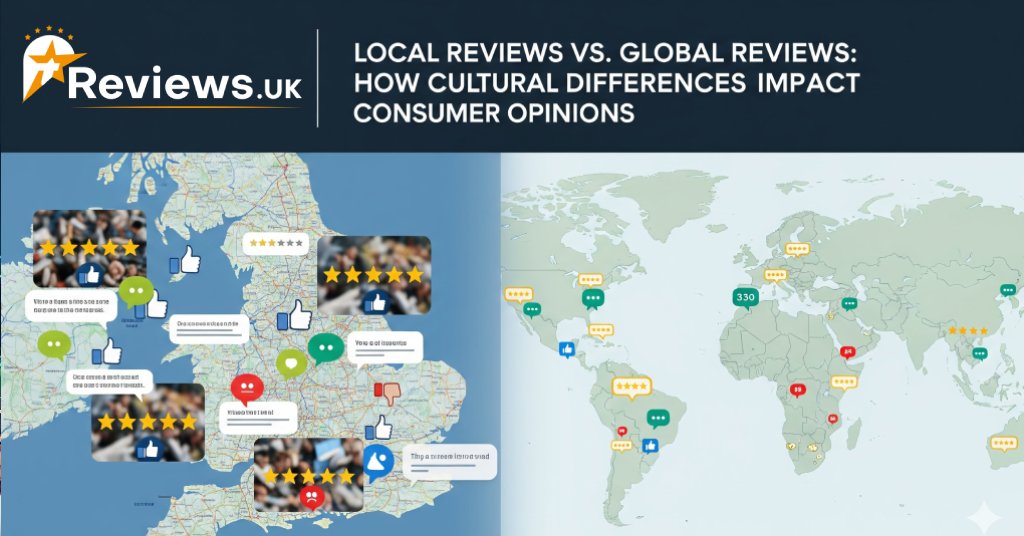Local Reviews vs. Global Reviews: How Cultural Differences Impact Consumer Opinions

Cross-cultural consumption behavior is impacting the perceptions of products and services across the globe. As shopping goes global, reviews have become ever more pivotal in determining what people buy. Local views are influenced by familiar traditions, values, and tastes, so how does the global community weigh in? Divergent behavior patterns such as these are indicative of how culture influences judgment and trust in online comments.
Customers across regions perceive brands differently, which represents different social norms and customer expectancies. A favorable comment in one market may mean little in another country. It is important to know these differences to be able to reach the audiences and to keep the reputation. Via best review sites UK or across the globe, businesses need to see how cultural influences perceptions. Local vs Global Reviews In this blog, I consider local and global reviews, looking at how culture, language, and style of communication all impact customer feedback and influence purchasing decisions around the world.
The Influence of Culture on Consumer Behavior
The influence of culture on consumer behavior cannot be overstated. Cultural background determines the way people read information, appraise brands, and decide to buy. People in different areas have different features of products according to their social standards, values, and daily lives.
For instance, Western consumers could emphasize product innovation and efficiency, while Eastern cultures would emphasize reliability and face. These differences are evident in online reviews. A comment on daring design might strike a chord in one region but fall flat in another. Businesses leveraging insights from feedback should consider these cultural dimensions so that they do not misinterpret which customer priorities are most important.
Local Reviews
Local reviews are opinions that are attached to regional culture and lifestyle. These are also often region-specific to certain geographic needs and standards. Consumers trust them because they look like familiar, likeable faces.
A London Sutton-based Cafe loved for “friendly staff and cozy atmosphere” matches the UK’s hospitality and comfort-gear preferences. Western shopping & fashion reviews platforms for a specific location ensure that you can only find products and services that are up to your regional standards. Companies that do not pay attention to local reviews are sure to miss out on an awful lot of insights. Local-culture-based preferences.
Global Reviews
Global reviews are aggregated from audiences everywhere. They offer an insight into how products are performing across markets. Overseas buyers rely on them to assess consistency, quality, and universal appeal.
But what appeals to one culture’s customer might alienate another. Something held up as a luxury product in Europe might appear excessive in a market that values practicality. This distinction must be recognised by international review analysis to design targeted strategies. Global lens expands the horizon, but may weaken certain unique cultural essences if not interpreted correctly.
Cultural Dimensions Affecting Review Perceptions
Because there are so many cultural dimensions that influence the way people view reviews. And these factors are what underlie why people in different places or with different values react in opposite ways to the same feedback. These contrasts need to be well understood by businesses led by product designs, marketing, and service delivery.
Individualism vs. Collectivism
In individualistic cultures, it is more likely that reviews express personal experience and self-expression. Consumers appreciate independent perspectives and a personal recommendation. In contrast, in collectivistic cultures, reviews signify group consensus and communal endorsement. Referrals from family or friends carry more weight than any single review. It’s important to notice this discrepancy, so you can work with it and fit within the local values, responding to cultural differences in consumer reviews.
High-Context vs. Low-Context Communication
High-context cultures, like Japan or China, use implicit messages and the common knowledge of groups. Reviews are not always straightforward. In low-context cultures, like the US or Germany, people like to hear direct statements. Responses need to be tailored to the way people like to communicate. Misreading these signals can result in complications or offense.
Power Distance
Power distance is how customers perceive authority and expertise in reviews. Expert advice or implied authority is weighed heavily in cultures with high power distance. In relatively low-power-distance cultures, informal consumer input is equally esteemed. Realizing this is what enables companies to sort out who it is that “knows everybody in town” for certain localities.
Uncertainty Avoidance
High uncertainty avoidance cultures like having a long, detailed review that includes product reliability and safety. Before buying these unfamiliar brands, shoppers want reassurance. On the other hand, less uncertainly avoidant cultures will tend towards the preference of innovation, and may appreciate grand statements and striking features. When influencing Local vs global reviews impact this dimension is responsible for one marketplace requiring all the information possible, while another one does not care and creates items with some details.
Time Orientation
Three, time reference influences the extent to which customers compare the long-term than the immediate benefit of performance. Long-term oriented cultures are influenced by reviews with the language that glorifies durability and long-term value. In the short-termist cultures of many schools, the instant sound bite and instant gratification rule. Enterprises need to monitor which priorities are of greatest concern to their target audience.
Language and Communication Barriers
Language barriers also have an effect on the way reviews are composed and read. Soft facial expressions or words absurdly connected to an idiom may lead international readers to misunderstand a positive comment. Brands should be mindful to translate customer feedback accurately. Transparent communication can preserve trust and leave no room for misinterpretation for reviewers and potential buyers.
Translation Nuances
To me, that is where a straightforward translation fails to capture cultural emotional content. A rave in one language can seem tepid in bad translation.” Global businesses conducting consumer opinion cultural variations studies should consider investing in local translations to maintain messaging authenticity. Tone and context are important to make the reviews reflect real consumer feedback across markets.
Regional Dialects and Slang
Then there is regional slang and dialect. A word or phrase that is a signal of approval in one culture can read as empty or worse on the page somewhere else. Unlocking the secrets behind how users express approvals or disapprovals enables companies to more accurately process reviews and not become identity theft at a global scale.
Non-Verbal Cues and Emojis
People are quick to use emojis and symbols to express feelings in online reviews. But there are other interpretations for these icons outside of the Western world. The thumbs-up gesture might be a sign of approval in one country, but a sign of disrespect in another. Businesses should consider these cross-cultural consumer behavior signals critically in interpretation.
Product and Service Expectations Across Cultures
But so do customer demands, and those requests can vary greatly from culture to culture. In some markets, rapid delivery is the measure of service quality. In others, the personal touch is more important. Reviews reflect these diverse priorities. Companies that don’t grasp cultural expectations will misread the feedback and make the wrong call. Retailers that can evaluate how cultural differences influence consumer opinions start to produce better products tailored to satisfy each audience.
The Role of Technology in Studying Worldwide Feedback
Today’s analytics tools allow companies to analyze enormous databases of reviews and other online content. AI platforms can spot regional sentiment patterns as well as cultural tone variances and can bring attention to common trends. Such learnings help refine global plans. Automated sentiment analysis, within a framework for human review, helps reduce the risk of misreading cultural signals. Companies obtain real-time insight into local requirements in global markets.
Applying learning for culture when marketing
Comprehending reviews is useful only if businesses then act on what they learn, sellers say. Tactic #3: Tailor Branding, Messaging, and Customer Service by Market / tackled cultural insights. Cultural insights provide key learnings that enable companies to optimize their branding, messaging, and customer service per market. Training using material that is vivid and based on reality, including familiar language and references, gains greater acceptance. Businesses leveraging feedback also help customers feel their cultural identity and unique preferences are respected.
Conclusion
Knowing the culture of consumer reviews is very important for companies working in the worldwide market. Regardless of whether reviews are from best review sites UK or bases worldwide, businesses need to honour individual values, channels of communication, and sets of expectations. Local reviews provide insight into the preferences of local community members, and global reviews reveal trends in overall performance.
The interpretations of these views based on cultural dimensions achieve an accurate understanding and sound decisions. Those brands that focus on these localized techniques build trust and loyalty, which is what causes long-term success. Cultural understanding is what helps companies make products and services that work everywhere. “Respecting cultural nuances is not optional in today’s multicultural marketplace. Knowing how to respect these nuances is vital in gaining credibility and sustaining a competitive edge.”











